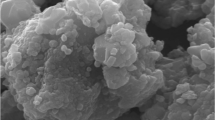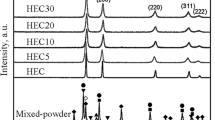Abstract
This paper discusses the influence of Ti3AlC2—MAX phase addition, intended to act as a sintering activator and a strengthening phase, to silicon carbide. The composites are prepared via powder processing and consolidated using the spark plasma sintering (SPS) method. The effects of the Ti3AlC2 addition on microstructure, sinterability, and mechanical properties were evaluated. The addition of MAX phases allows for the production of high-density sinters containing TiC as the reinforcing phase. Titanium carbide is formed as a result of the thermal degradation of Ti3AlC2. The highest hardness of 2540 HV5 was obtained for a sample containing 15 wt. % of Ti3AlC2, while the highest fracture toughness of 4.15 MPa*m0.5 for the sample containing 20 wt. %.










Similar content being viewed by others
Data availability
The data analyzed during the current study will be available upon reasonable request.
References
Longbiao L. Tensile strength of ceramic-matrix composites. In: Jones G, Silva IC, editors. Durability of ceramic-matrix composites. Elsevier; 2020. p. 145–91. https://doi.org/10.1016/C2018-0-03346-0.
Bansal NP. Handbook of ceramic composites. Dordrecht: Kluwe Academic Publisher; 2005.
Serbena FC, Zanotto ED. Internal residual stresses in glass-ceramics: a review. J Non-Cryst Solids. 2012;358:975–84. https://doi.org/10.1016/j.jnoncrysol.2012.01.040.
Porwal H, Grasso S, Reece MJ. Review of graphene–ceramic matrix composites. Adv Appl Ceram. 2013;112:443–54. https://doi.org/10.1179/174367613X13764308970581.
Sabry I, Hewidy AM. Underwater friction-stir welding of a stir-cast AA6061-SiC metal matrix composite: optimization of the process parameters, microstructural characterization, and mechanical properties. Mater Sci Pol. 2022;40:68–115. https://doi.org/10.2478/msp-2022-0013.
Petrus M, Wozniak J, Jastrzębska A, Kostecki M, Cygan T, Olszyna A. The effect of the morphology of carbon used as a sintering aid on the sinterability of silicon carbide. Ceram Int. 2018;44:7020–5. https://doi.org/10.1016/j.ceramint.2018.01.136.
van Rijswijk W, Shanefield DJ. Effects of carbon as a sintering aid in silicon carbide. J Am Ceram Soc. 1990;73:148–9. https://doi.org/10.1111/j.1151-2916.1990.tb05109.x.
Delobel F, Lemonnier S, D’Elia R, Cambedouzou J. Effects of density on the mechanical properties of spark plasma sintered β-SiC. Ceram Int. 2020;46:13244–54. https://doi.org/10.1016/j.ceramint.2020.02.101.
Mamedov V. Spark plasma sintering as advanced PM sintering method. Powder Metall. 2002;45:322–8. https://doi.org/10.1179/003258902225007041.
Guillon O. Field-assisted sintering technology/spark plasma sintering: mechanisms, materials, and technology developments. Adv Eng Mater. 2014;16:830–49. https://doi.org/10.1002/adem.201300409.
Anstis GR, Chantikul P, Lawn BR, Marshall DB. A critical evaluation of indentation techniques for measuring fracture toughness: I, direct crack measurements. J Am Ceram Soc. 1981;64:533–8. https://doi.org/10.1111/j.1151-2916.1981.tb10320.x.
Curtin WA. Theory of mechanical properties of ceramic-matrix composites. J Am Ceram Soc. 1991;74:2837–45. https://doi.org/10.1111/j.1151-2916.1991.tb06852.x.
Román-Manso B, Domingues E, Figueiredo FM, Belmonte M, Miranzo P. Enhanced electrical conductivity of silicon carbide ceramics by addition of graphene nanoplatelets. J Eur Ceram Soc. 2015;35:723–2731. https://doi.org/10.1016/j.jeurceramsoc.2015.03.044.
Ohya Y, Hoffmann MJ, Petzow G. Sintering of in-situ synthesized SiC–TiB2 composites with improved fracture toughness. J Am Ceram Soc. 1992;75:2479–83. https://doi.org/10.1111/j.1151-2916.1992.tb05600.x.
Petrus M, Woźniak J, Cygan T, Lachowski A, Moszczyńska D, Adamczyk-Cieślak B, Rozmysłowska-Wojciechowska A, Wojciechowski T, Ziemkowska W, Jastrzębska A, Olszyna A. Influence of Ti3C2Tx MXene and surface-modified Ti3C2Tx MXene addition on microstructure and mechanical properties of silicon carbide composites sintered via spark plasma sintering method. Materials. 2021;9:3558. https://doi.org/10.3390/ma14133558.
Petrus M, Woźniak J, Cygan T, Lachowski A, Rozmysłowska-Wojciechowska A, Wojciechowski T, Ziemkowska W, Chlubny L, Jastrzębska A, Adamczyk-Cieślak B, Olszyna A. Silicon carbide nanocomposites reinforced with disordered graphitic carbon formed in situ through oxidation of Ti3C2 MXene during sintering. Arch Civ Mech Eng. 2021;21:1–12. https://doi.org/10.1007/s43452-021-00236-0.
Petrus M, Wozniak J, Cygan T, Adamczyk-Cieslak B, Kostecki M, Olszyna A. Sintering behaviour of silicon carbide matrix composites reinforced with multilayer graphene. Ceram Int. 2017;43:5007–13. https://doi.org/10.1016/j.ceramint.2017.01.010.
Barsoum MW, Radovic M. Elastic and mechanical properties of the MAX phases. Annu Rev Mater Res. 2011;41:195–227. https://doi.org/10.1146/annurev-matsci-062910-100448.
Barsoum MW, El-Raghy T. The MAX phases: Unique new carbide and nitride materials: tertiary ceramics are soft and machinable, yet heat-tolerant, strong and light weight. Am Sci. 2001;89:334–43. https://doi.org/10.1511/2001.4.334.
Jeitschko W, Nowotny H. Die Kristallstruktur von Ti3SiC2—ein neuer Komplexcarbid-Typ. Monatshefte für Chem Chem Mon. 1967;98:329–37. https://doi.org/10.1007/BF00899949.
Low IM, Pang WK. Thermal stability of MAX phases. Key Eng Mater. 2014;617:153–8. https://doi.org/10.4028/www.scientific.net/KEM.617.153.
Qian XK. Methods of MAX-phase synthesis and densification—I. In: Low IM, editor. Advances in science and technology of Mn+1AXn phases. Amsterdam: Elsevier; 2012. p. 1–19. https://doi.org/10.1533/9780857096012.1.
Barsoum MW, Brodkin D, El-Raghy T. Layered machinable ceramics for high temperature applications. Scr Mater. 1997;36:535–41. https://doi.org/10.1016/S1359-6462(96)00418-6.
Frodelius J, Sonestedt M, Björklund S, Palmquist J, Stiller K, Högberg H, Hultman L. Ti2AlC coatings deposited by high velocity oxy-fuel spraying. Surf Coat Technol. 2008;24:5976–81. https://doi.org/10.1016/j.surfcoat.2008.06.184.
Sonestedt M, Frodelius J, Sundberg M, Hultman L, Stiller K. Oxidation of Ti2AlC bulk and spray deposited coatings. Corros Sci. 2010;12:3955–61. https://doi.org/10.1016/j.corsci.2010.08.004.
Barsoum MW, El-Raghy T. Synthesis and characterization of a remarkable ceramic: Ti3SiC2. J Am Ceram Soc. 1996;79:1953–6. https://doi.org/10.1111/J.1151-2916.1996.TB08018.X.
Jiaoqun Z, Bingchu M. Effect of aluminum on synthesis of Ti3SiC2 by spark plasma sintering (SPS) from elemental powders. J Mater Synth Process. 2002;6:353–8. https://doi.org/10.1023/A:1023889920488.
Zhou W, Mei B, Zhu J, Hong X. Synthesis of high-purity Ti3SiC2 and Ti3AlC2 by spark plasma sintering (SPS) technique. J Mater Sci. 2005;8:2099–100. https://doi.org/10.1007/s10853-005-1245-z.
Chen JX, Zhou YC, Zhang HB, Wan DT, Liu MY. Thermal stability of Ti3AlC2/Al2O3 composites in high vacuum. Mater Chem Phys. 2007;104:109–12. https://doi.org/10.1016/j.matchemphys.2007.02.091.
Gusev AI. Mechanical properties of nonstoichiometric cubic titanium carbide TiCy. Phys Chem Chem Phys. 2021;23:18558–67. https://doi.org/10.1039/D1CP02697F.
Barsoum MW, Houng B. Transient plastic phase processing of Titanium–Boron–Carbon composites. J Am Ceram Soc. 1993;76:1445–51. https://doi.org/10.1111/J.1151-2916.1993.TB03924.X.
Nayebi B, Asl MS, Akhlaghi M, Ahmadi Z, Tayebifard SA, Salahi E, Shokouhimehr M, Mohammadi M. Spark plasma sintering of TiB2-based ceramics with Ti3AlC2. Ceram Int. 2021;7:11929–34. https://doi.org/10.1016/j.ceramint.2021.01.033.
Zheng L, Li F, Zhou Y. Preparation, Microstructure, and mechanical properties of TiB2 using Ti3AlC2 as a sintering aid. J Am Ceram Soc. 2012;95:2028–34. https://doi.org/10.1111/j.1551-2916.2012.05204.x.
Shahedi Asl M, Nayebi B, Akhlaghi M, Ahmadi Z, Tayebifard SA, Salahi E, Shokouhimehr M, Mohammad M. A novel ZrB2-based composite manufactured with Ti3AlC2 additive. Ceram Int. 2021;47:817–27. https://doi.org/10.1016/j.ceramint.2020.08.193.
Tan Y, Luo H, Zhang H, Zhou X, Peng S. Fabrication of toughened B4C composites with high electrical conductivity using MAX phase as a novel sintering aid. Ceram Int. 2016;42:7347–52. https://doi.org/10.1016/j.ceramint.2016.01.133.
Tan YQ, Chen C, Li FZ, Zhang HB, Zhang GJ, Peng SM. Enhancement of sinterability and mechanical properties of B4C ceramics using Ti3AlC2 as a sintering aid. RSC Adv. 2015;5:76309–14. https://doi.org/10.1039/C5RA14191E.
Petrus M, Wozniak J, Cygan T, Pawlak W, Olszyna A. Novel alumina matrix composites reinforced with MAX phases-microstructure analysis and mechanical properties. Materials. 2022;15:6909–24. https://doi.org/10.3390/ma15196909.
Pang WK, Low IM, O’Connor BH, Studer AJ, Peterson VK, Sun ZM, Palmquist JP. Comparison of thermal stability in MAX 211 and 312 phases. J Phys Conf Ser. 2010;25:1–4. https://doi.org/10.1088/1742-6596/251/1/012025.
Kornaus K, Grabowski G, Raczka M, Zientara D, Gubernat A. Mechanical properties of hot-pressed SiC-TiC composites. Process Appl Ceram. 2017;11:329–36. https://doi.org/10.2298/PAC1704329K.
Kim YW, Lee SG, Lee YI. Pressureless sintering of SiC-TiC composites with improved fracture toughness. J Mater Sci. 2000;35:5569–74. https://doi.org/10.1023/A:1004848828322.
Alliegro RA, Coffin LB, Tinklepaugh JR. Pressure-sintered silicon carbide. J Am Ceram Soc. 1956;39:386–9. https://doi.org/10.1111/j.1151-2916.1956.tb15609.x.
Vlaskina S, Mishinova G, Vlaskin V, Rodionov V, Svechnikov G. 3C–6H transformation in heated cubic silicon carbide 3C–SiC. Semicond Phys Quantum Electron Optoelectron. 2011;14:432–6. https://doi.org/10.15407/spqeo14.04.432.
Xu H, Bhatia T, Deshpande SA, Padture NP, Ortiz AL, Cumbrera FL. Microstructural evolution in liquid-phase-sintered SiC: part I, effect of starting powder. J Am Ceram Soc. 2001;84:1578–84. https://doi.org/10.1111/j.1151-2916.2001.tb00880.x.
Deshpande SA, Bhatia T, Xu H, Padture NP, Ortiz AL, Cumbrera FL. Microstructural evolution in liquid-phase-sintered SiC: part II, effects of planar defects and seeds in the starting powder. J Am Ceram Soc. 2001;84:1585–90. https://doi.org/10.1111/j.1151-2916.2001.tb00881.x.
Funding
Financial support from the Polish Ministry of Science and Higher Education is gratefully acknowledged.
Author information
Authors and Affiliations
Corresponding author
Ethics declarations
Conflict of interest
The authors have no competing interests to declare relevant to this article's content.
Ethical approval
This manuscript presents original work that has not been published previously and is not under consideration for publication elsewhere. No studies on human or animal subjects were conducted.
Additional information
Publisher's Note
Springer Nature remains neutral with regard to jurisdictional claims in published maps and institutional affiliations.
Rights and permissions
Springer Nature or its licensor (e.g. a society or other partner) holds exclusive rights to this article under a publishing agreement with the author(s) or other rightsholder(s); author self-archiving of the accepted manuscript version of this article is solely governed by the terms of such publishing agreement and applicable law.
About this article
Cite this article
Wozniak, J., Petrus, M., Moszczynska, D. et al. The consolidation of SiC ceramics using MAX phases as a new family of sintering activators. Archiv.Civ.Mech.Eng 24, 101 (2024). https://doi.org/10.1007/s43452-024-00934-5
Received:
Revised:
Accepted:
Published:
DOI: https://doi.org/10.1007/s43452-024-00934-5




